Ghost shrimps and cherry shrimps are famous creatures in the invertebrate rearing hobby. Unfortunately, most people get confused when deciding between the two and get the wrong one for their needs. Both cherry and ghost shrimp have different uses, appearances, and functions.
There are quite a few similarities. This guide will tell you the appearance, care instructions, breeding, functions, similarities, and differences between ghost shrimps and cherry shrimps.
Table of Contents
Ghost Shrimp And Cherry Shrimp [A Quick Overview]
Ghost shrimp and cherry shrimp are small, freshwater invertebrates that are popular among aquarists. Ghost shrimp are transparent, while cherry shrimp are red. Both species are easy to care for and can be kept in a community tank with other peaceful fish. They are also popular as feeder shrimp for larger predatory fish.
Cherry Shrimp vs. Ghost Shrimp

Cherry Shrimps
Cherry shrimp (Neocaridina Heteropoda) is also known as red cherry shrimp. They are a famous species of invertebrates that originate from Taiwan. They are easy to care for and exist in their tanks. Their family Atyidae consists of more than twenty different types of shrimps. We call cherry shrimps red cherry shrimps because of their vibrant red-colored bodies. They light up any tank and act as peaceful tankmates for most small fish.
Hobbyists add cherry shrimp to their tanks because of their unique algae-eating ability. They will help you in keeping your tank debris free. Cherry shrimps go through grading. Lower grades have a softer pink shade, and higher ones have a blood-red one. Their profound red color results from careful selective breeding over the years. They thrive in extreme conditions, too, and are pretty resilient.
Ghost Shrimps
Ghost shrimps (called Palaemonetes Paludosus) often become food for other fish.
They have a white, ‘ghost-like’ appearance. This makes them less attractive than their cherry shrimp counterparts. Despite this, some people keep ghost shrimps as pets. They are perfect for beginners because they are easy to take care of. In addition, they are not picky about water conditions.
A similarity between the two is that they are both cleaning agents. Ghost shrimps will get rid of any algae growing in the tank too. However, ghost shrimp can often become bullies apart from their cleaning abilities. They may bully smaller shrimp and try to eat them.
Ghost shrimps can become good tankmates, but they are often not kept inside tanks. As a result, they may become food for the fish. Overeating the ghost shrimps is terrible for the shrimp population and the fish in a community tank. There are also a couple of things that you need to know if you are getting ghost shrimps for your shrimp tank.
Ghost shrimps are pricier because they are hard to breed. As we will outline later, their breeding process is a tricky one to get right. This is one of the main reasons hobbyists prefer cherry shrimps over ghost shrimps.
Physical Appearance
Cherry Shrimp
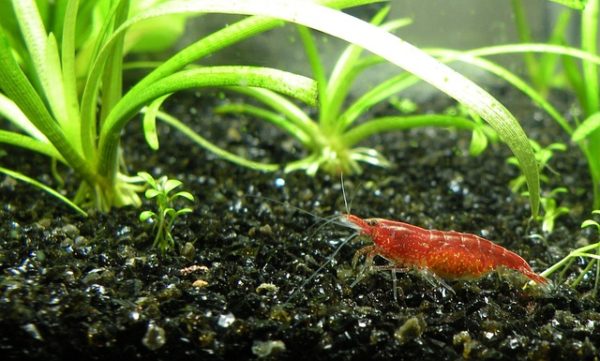
Cherry shrimp is a dwarf shrimp variety that is famous in the industry. The cherry shrimps usually grow as long as 1 to 1.5 inches throughout their short life. Unlike most fish species, the male shrimps are shorter than the females.
The most striking feature of cherry shrimp is their deep red hue. Cherry fish are graded into several categories, depending on the intensity and the shade of red they have. Their body color can go from a blood red to a light pink-red shade. The higher the grade of a cherry shrimp, the darker their red appearance is. The grading is as follows:
- Red cherry shrimp: These are the typical red cherry shrimp species, but they are the lowest in the grade. Their color is off-white, interspersed with red patches throughout.
- Sakura cherry shrimp: the Sakura cherry shrimps are pinkish. They are like the sakura (cherry blossoms, in Japanese). They have some clear patches on them as well.
- Fire red shrimp: this shrimp has a red color.
- Painted fire red shrimp: These are the purest of them all because their color is vivid. They are rare, expensive, and the highest on the grading chart.
Females are bigger and more colorful than males. It is difficult to tell them apart because they look so similar. One telling trait is that they have an orange sack on their stomachs as the females grow up. This signifies their sexual maturity, and this sack holds their eggs.
Ghost shrimp
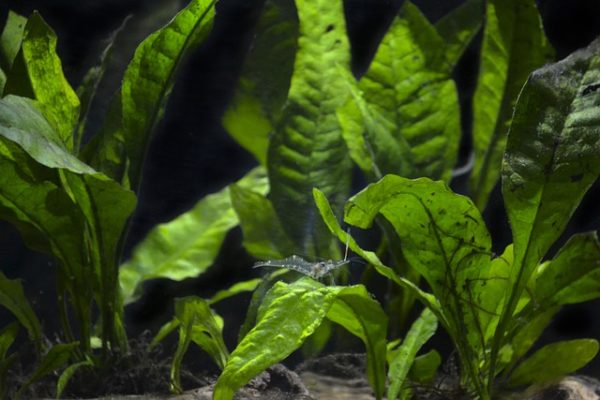
Ghost shrimp have no color or grading variations. Their body is transparent, and you can see all their internal organs through them. It is fascinating to observe the littlest inner workings of their body. You can see things such as their digestion, breathing, etc.
In size, they are more significant than cherry shrimps. Ghost shrimps can grow up to 2 inches long. However, most of them average around 1.5 to 1.6 inches and appear the same size as a cherry shrimp.
Even with ghost shrimps, the females are more significant than the males.
Ghost shrimps also have two antennae, shorter than the other. The function of the antennae is to sense what is happening around them and scent food. They act like small noses and sensory organs for the shrimp.
Water Parameters
Cherry Shrimps
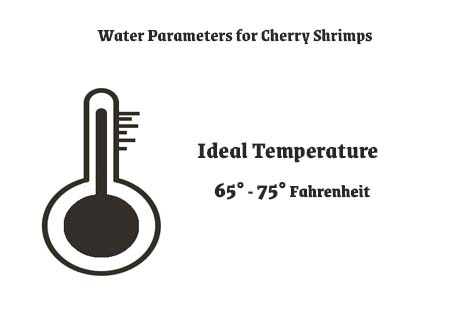
Cherry Shrimps do not need a vast space – a small 5-gallon tank is enough to house a couple of cherry shrimps. The ideal water conditions for cherry shrimp are a constant pH range of 6.5 to 8. In addition, the tank’s temperature has to be a continuous 65 to 75 degrees F.
The GH or the general hardness of the water should be 6 to 8 PPM. The KH or carbonate hardness should be 1 to 4 PPM.
Ghost Shrimps
Ghost shrimps have different water parameters. The ideal water conditions for ghost shrimp are a constant pH range of 7 to 8. In addition, the tank’s temperature has to be a continuous 65 to 75 degrees F. The GH or the general hardness of the water should be 4 to 14 PPM. The KH or carbonate hardness should be 0 to 10 PPM.
Diet
Cherry shrimp
Cherry shrimps are picky eaters. Although they are good algae cleaners, they will not eat about anything. They like specific foods more than the others. Cherry shrimps enjoy eating algae, vegetables, and even outside food. Their primary food is algae, but even then, cherry shrimp will pick and choose the kind of algae they eat. They will stay away from the hairy or vast amount of algae.
You may supplement their diets by adding algae wafers or let them much on the algae growing on the plants. You may feed them commercial foods like sinking pellets, etc.
You can give them blanched vegetables, such as lettuce, spinach, etc., once or twice a week for overall nutrition.
Ghost shrimp
Ghost shrimp are self-sufficient. They do not need add-on food apart from the algae growing in the tank. Unlike the cherry shrimps, they do not pick and choose their food and eat whatever is given.
Ghost shrimps are good at scavenging food particles. But, an additional supplement to keep them healthy is to provide them with calcium. They will also eat any dead animals in the tank and feed on plant matter throughout the day.
Aggressiveness
Cherry shrimps are peace-loving creatures and will mind their own business. They are pretty timid in the sense that they need protection from predators. Unlike cherry shrimps, ghost shrimps are not scared. They will be intimidated by bigger fish, but these will dominate them when it comes to other shrimp. Ghost shrimp often eat smaller fish and other shrimp – and they can get aggressive if there is any trespassing through their territory.
Lifespan
Cherry shrimps and ghost shrimps both do not live long. Their average lifespan is about a year or thirteen months. So even of a shrimp is well-cared for, it will not live for longer than a year and a half.
Breeding
Cherry Shrimp
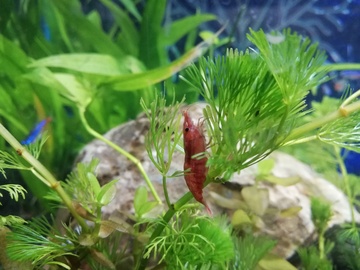
Cherry shrimps are breeding machines. They produce fast, and they leave plenty of offspring. Their breeding method is pretty easy to follow and replicate. Even newbie hobbyists can breed them.
Cherry shrimps will breed better if a special breeding tank if you prepare a special breeding tank for them. Ensure that you plant the tank so that the mating pair and their children feel warm and safe. The mating couple needs to feed on high-protein food leading up to introducing them to the breeding tank.
Cherry shrimps usually breed in summer, so to make them more comfortable, you can raise the temperature of the main tank to 82 degrees F.
Once they have mated, you will spot the female with eggs under her tail, which she will fan so that her offspring can get enough oxygen. It takes four weeks or a little more for the eggs to hatch. After that, you can either put the fry into the main aquarium to feed themselves from the plant matter, or introduce crushed plant matter into the new tank.
Even though the adult parents do not eat their children, they will leave them to protect themselves.
Ghost Shrimp
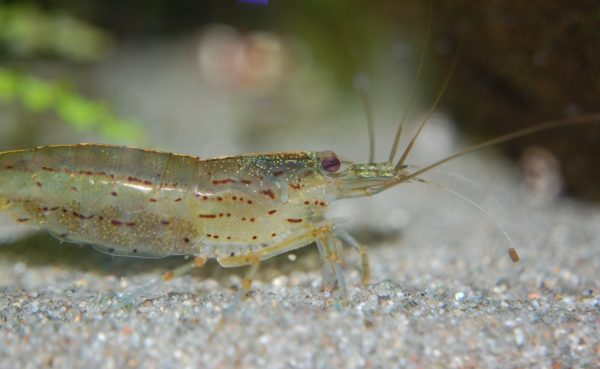
Ghost shrimp are not easy to breed. The environment that they are in impacts their breeding. This is why most people only use them as a feeding option.
If you want to try it, you will have to prepare a breeding tank to breed ghost shrimp. Pick the mated pair, and introduce them to the tank once you spot the saddle underneath the females. The females will lay eggs every few weeks and these eggs are visible in the form of spots near the female’s legs. The male will fertilize the eggs, and then after three weeks or so, the eggs will begin to hatch. You might want to remove the female from the tank not to eat her offspring. The breeding tank needs to have a filter to ensure clean water for the fry. You should also put on a thin layer of sand or substrate and add some plant bits or debris into the tank for fry to feed. Ensure that the particles are fine and small.
Once you spot the fry with legs, they are old enough to eat food that adult ghost shrimps can eat. After five weeks or so, they should be grown and can move back to the main tank.
Tank Mates
Both cherry shrimps and ghost shrimps have similar types of tank mates that they can live with. The one main rule is not to keep any huge fish that eat the shrimp. Also, do not add any aggressive or possessive fish to the tank.
Ideal tankmates for a Cherry Shrimp tank are freshwater snails like ivory, nerite, Malaysian trumpet snails, etc., tetras (small ones), plecos, dwarf gourami fish, and catfish such as corydoras and otocinclus catfish.
Ideal tankmates for a Ghost shrimp tank are: tetras, hatchet fish, danios, kuhli loaches, zebra loaches, corydoras catfish, cherry barbs, etc.
Survival Rate
Cherry shrimps can not make changes in water conditions as well as ghost shrimps can. Therefore, ghost shrimps are more resilient and outlive cherry shrimps.
Cherry shrimps are less hardy than ghost shrimps. Ghost shrimps are not picky about changes in pH, water hardness and adapt well. This might also be because ghost shrimps are more significant and bigger than cherry shrimps.
Survival rating for ghost shrimps is way more than that of cherry shrimps.
Differences and Similarities Between Ghost Shrimp And Cherry Shrimp
Let us take a look at summarised look at what sets ghost and cherry shrimps apart, and what they share in common.
Differences between Ghost Shrimp and Cherry Shrimp:
As far as colors go, the cherry shrimp is more colorful and attractive than the ghost shrimp. Its variety of grades sets it apart from the ghost shrimp who only come in a luminescent white shade. In addition, they are smaller in size compared to the latter. This allows you to stock cherry shrimps in more number in your tank as you would do with ghost shrimps. Ghost shrimps are not comfortable sharing their space a lot, even with their own species. Their bigger size ensures that a tank does not have more ghost shrimp than its space.
As far as their temperament goes, cherry shrimp are more peaceful than ghost shrimp. As we have seen, ghost shrimp can turn into bullies towards smaller species such as small fish or even small shrimp. Ghost shrimp can turn aggressive if they do not have enough area of the tank for themselves.
If you are a breeder, or a novice starting with shrimp breeding, you will have a pleasant experience breeding cherry shrimps. They reproduce without much effort on the part of the caretaker. Compared to them, ghost shrimps can be a handful. If you do not know what you are doing, breeding ghost shrimp can turn into a harrowing task. They are difficult to breed because it is hard to suit the tank conditions for their breeding process.
If you have a tight budget, then cherry shrimps are not a species to look out for. However, if your function is a simple cleaning species, you will do well with ghost shrimps who cost less. Regardless, the ghost shrimp is cheaper when compared to the cherry shrimp.
Cherry shrimps are used as tank decorations often. Ghost shrimps serve as tank cleaners in most cases. If you want a brilliant, colorful addition to your tank, cherry shrimp is your go-to invertebrate.
The biggest difference between them is the translucent body of the ghost shrimp. Cherry shrimp have a thick red coat on them, whereas the ghost shrimp body is translucent, allowing us to see their organs.
Similarities between Ghost Shrimp and Cherry Shrimp:
Like their many differences, the two shrimp species have many similarities as well.
A ghost and a cherry shrimp approximately grow up to a similar size. There are cases where ghost shrimps grow bigger than cherry shrimps, but that does not happen often. For example, ghost shrimps may grow up to two inches, whereas some cherry shrimps will grow that long, or stop growing about one or one and half inches.
These shrimps live for the same time. Their lifespan is about a year or two. In spite of them eating a lot of food, they will age and die within a couple of years. The average lifespan of a ghost and a cherry shrimp is between twelve to thirteen months.
Their food eating habits are similar. They both prefer smaller fish, and other omnivorous food along with algae. In short, their lifespan, size and food groups them together.
Can I Keep Ghost Shrimp and Cherry Shrimp Together?
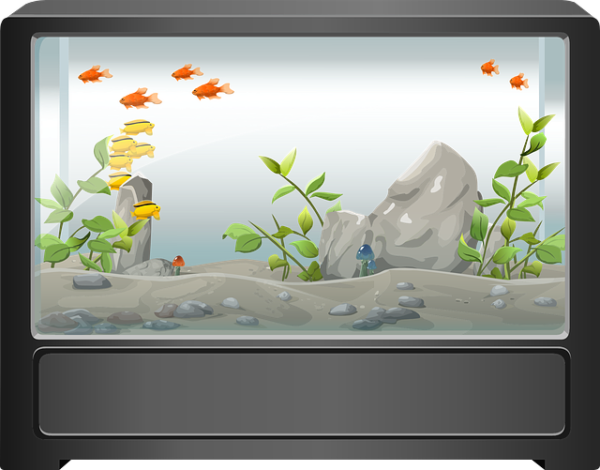
This is a tricky question because it has no definite answer. The opinions on this are biased and based on personal experiences. You can keep both ghost shrimps and cherry shrimps together, and no harm will come of it. But, several factors play a role in determining the comfort with which these shrimps will live together. To ensure that there is no tension or clash between the two, here are some things you can keep in mind:
- If you plan on keeping them both together, get a large enough tank to give each shrimp colony its own space. Shrimps might be small but get annoyed if someone tries to encroach on their area. Having a large tank will ensure that they leave each other alone.
- Out of the two species, ghost shrimps will usually bully cherry and the baby shrimps. Cherry shrimps are not aggressive and may get harassed as a result of this. Giving them enough food and space may avoid this situation.
- Out of the two species, ghost shrimps will usually bully cherry and the baby shrimps. Cherry shrimps are not aggressive and may get harassed as a result of this. Giving them enough food and space may avoid this situation.
- Out of the two species, ghost shrimps will usually bully cherry and the baby shrimps. Cherry shrimps are not aggressive and may get harassed as a result of this. Giving them enough food and space may avoid this situation.
Can Ghost Shrimp and Cherry Shrimp Breed?
Ghost shrimp are an different species than cherry shrimps. Ghost shrimp are very hard to breed due to the specific water conditions they require.
Since these two species are entirely apart in their family trees, there is no way that they can have any fertile shrimplets. Firstly, the tank conditions needed for cherry and ghost shrimps to live together are obstacles. When ghost shrimp breed (on the rare occasion), they need brackish water to raise their offspring. For cherry shrimp, as we have seen, this is completely opposite. Cherry shrimp need freshwater to raise their young ones. If these two species did somehow breed, their children would not survive.
Secondly, in the unique instance that their offsprings survive, they will likely be infertile.
As in most species, an inter-species union often results in infertile offspring. Many hobbyists have tried selectively breeding cherry shrimps with other species of shrimps but have been unsuccessful.
It is safe to say that it will be a failed experiment if you try to breed ghost shrimp with cherry shrimp.
Conclusion
As we have seen, both ghost shrimps and cherry shrimps have their pros and cons, differences and similarities. As a hobbyist, either will do the job if you know your main function for the shrimps. If you want a shrimp for decorative, ornamental purposes, then you should go for cherry shrimps because of their beauty and the bright red color. Ghost shrimps are better for algae-cleaning and tank maintenance, rather than cherry shrimps who, may be good at it but are selective when cleaning up all the debris. If you want to keep them as pets, then you may go in for either of them – they are similar in temperament and care. If you are a professional fishkeeper and looking to breed shrimp, cherry shrimps are way better.
We hope this guide has answered most of your queries and cleared up any confusion between the cherry and ghost shrimp. Whatever you plan on your shrimps doing, you can now make an informed decision after weighing in all the factors.
